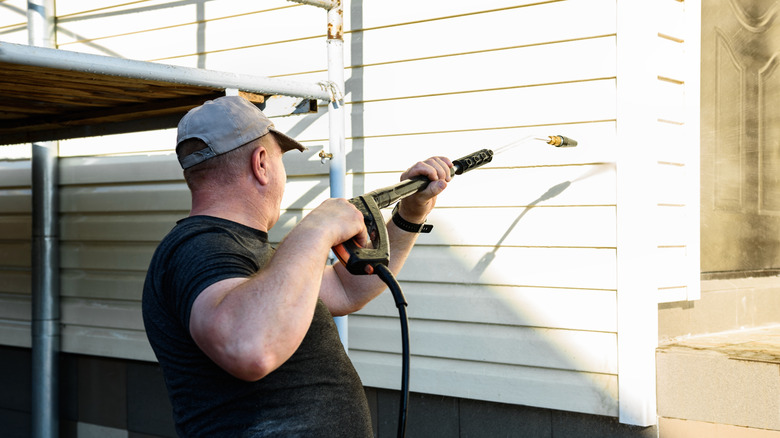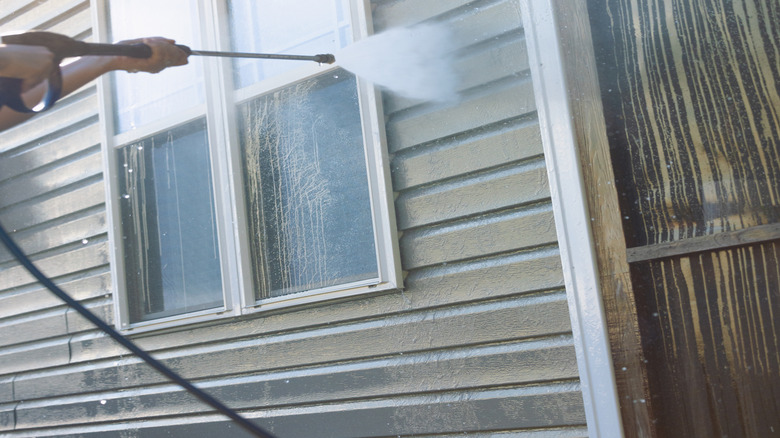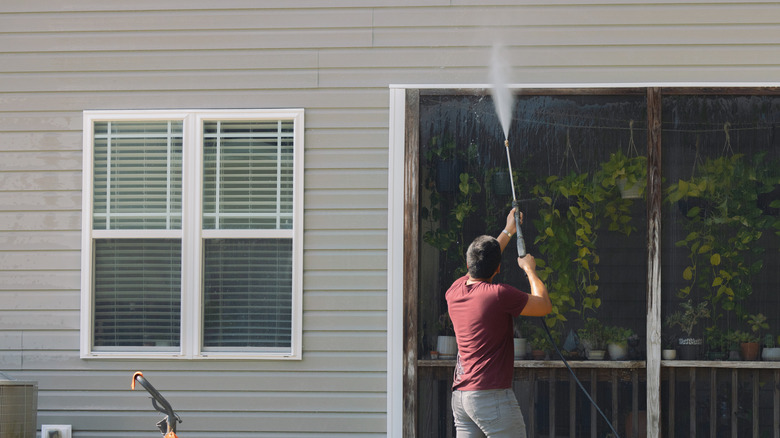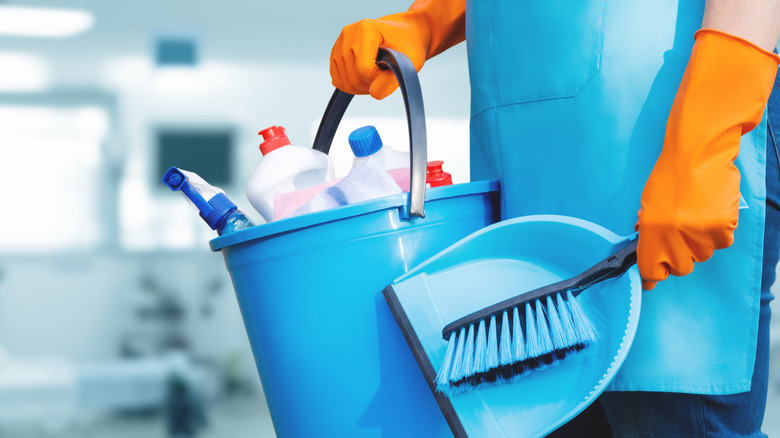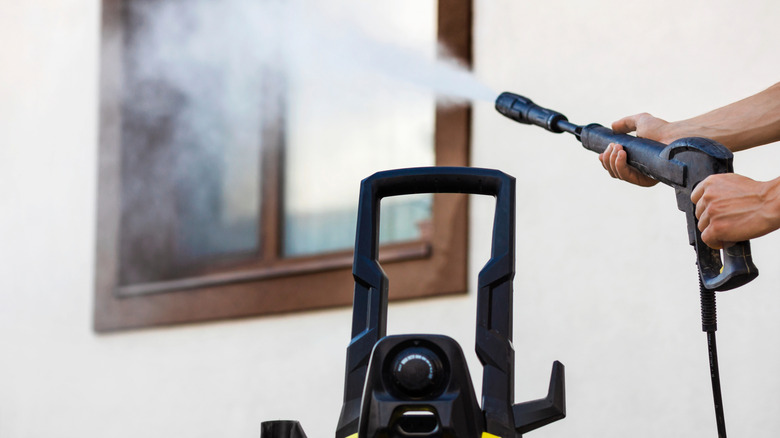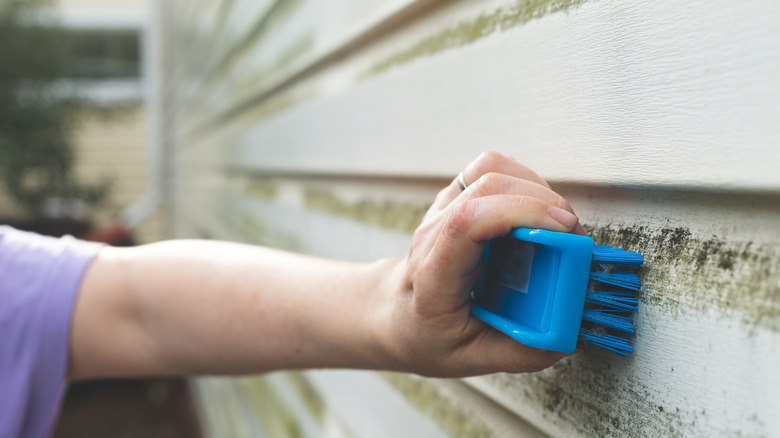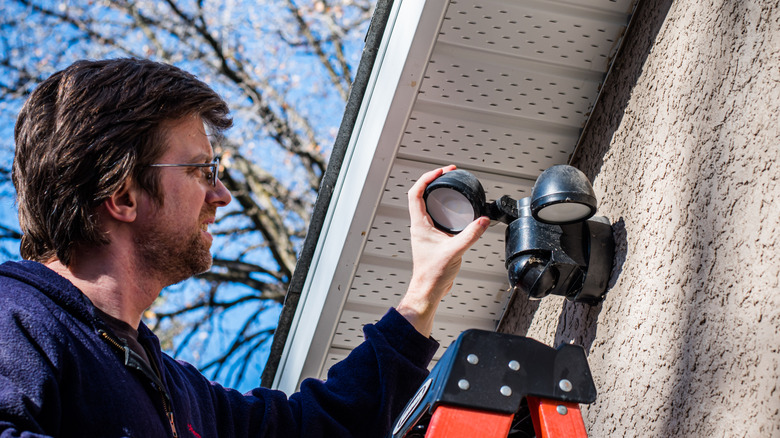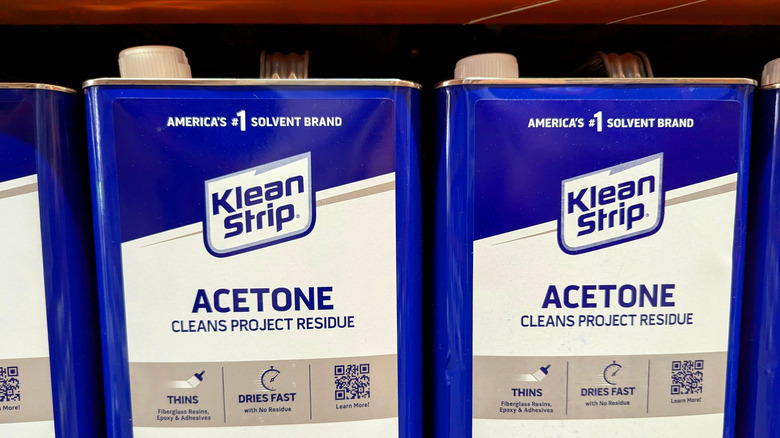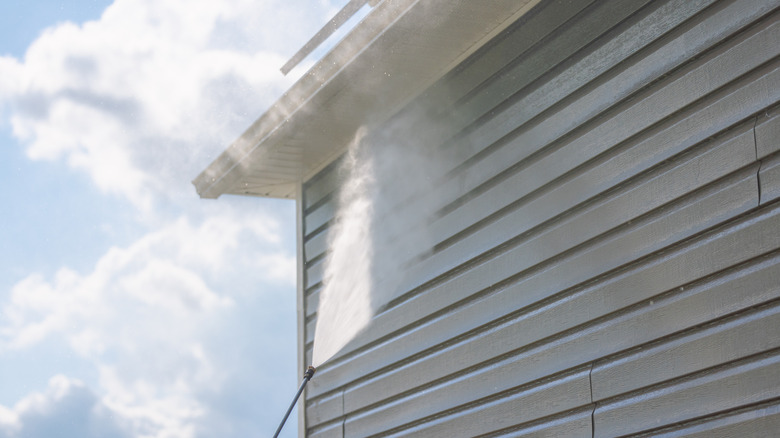12 Things You Should Never Do When Cleaning Vinyl Siding
We may receive a commission on purchases made from links.
Vinyl siding was first introduced during the post-World War II housing boom because it was cheaper than aluminum and required less maintenance than wood. But, at the time, the product was more likely to fade and even crack over time. By the 1970s, new research into polyvinyl chloride resins made the product more durable and resistant to ultraviolet rays. Since then, the material has become standard among builders. Drive through any neighborhood near you that was built after the 1970s, and you're guaranteed to see it. But although vinyl siding is touted for its low maintenance, you still have to clean off the mold and bird droppings at least once a year.
You can either pressure wash your siding or use a scrub brush. The former option is a bit quicker but pricier (because it requires a machine), while the latter is labor-intensive and somewhat dangerous because it requires you to climb a ladder. Either option can damage your vinyl siding or even the home under it. So, if you're interested in completing the job as safely and efficiently as possible while protecting your vinyl siding warranty, there are a few mistakes you should try to avoid.
Using a pressure washer too close to the vinyl
While it's important to be thorough when you pressure wash your home, you should always make sure to place your nozzle at a safe distance from the siding, especially if you're using a nozzle with a smaller opening. If you haven't power-washed before, you can adjust the spray by placing different nozzles, which have different openings, at the end of the lance, the stick containing a trigger that you hold while pressure washing. Large openings create low-pressure sprays that are good for rinsing, while small openings create high-pressure sprays that can remove mold but can also sometimes crack vinyl siding. Once your siding cracks, water can damage your house's frame, causing rot and mold growth. Even though a broad spray won't damage your house, it probably won't do the job, either.
You should generally try to keep the nozzle about 6 to 12 inches from the vinyl siding. The distance should vary depending on how powerful the machine is and which nozzle you decide to use. As a general rule, your pressure washer should have a PSI range between 1,300 and 2,000. If your pressure washer lands at the higher end of that spectrum, try starting with a wider-holed nozzle and working your way up.
Spraying upward
It's important to always keep both feet firmly planted on the ground when pressure washing your house. That's because you need to hold the lance firmly with two hands, which would be dangerous on a ladder. When you send a jet of water out of a wand at a 1,000 pounds per square inch, there's an equal and opposite reaction, so you can't remain stable on a ladder. One challenge this poses is that it sometimes makes it more convenient to spray upward, which can damage your home. When you spray upward, you blast water beneath the siding, where it can't escape. Over time, the wood beneath your vinyl may rot and turn moldy. This can cause immediate health issues and even pose a long-term damage to your home's structural integrity.
To stay on the ground while cleaning higher up on your house's walls, you can simply use an extension wand, which can give you up to an extra 12 feet of reach. Some extensions are even curved to prevent any water from spraying under the siding. Even if you don't decide to power-wash your house on your own, it's a good idea to make sure your contractor is using the right equipment, because you don't want to pay for it months or years down the line when you have a mold issue.
Applying cleaning solution when the siding is dry
One of the first steps of pressure washing a vinyl surface is to coat it with a cleaner. You can simply use a household cleaner, such as the detergent you use to wash your laundry. But you need to make sure that this detergent has time to break down the mold and lift it from the house, and if the vinyl is dry, then the detergent will quickly dry out as well. This can cause streaks to form on the vinyl surface, and you might have trouble removing them.
As long as the weather is fair, the best way to prevent the sun from drying your detergent is to first spray the house with fresh water, which you can do with your pressure washer. This coat of water will allow your detergent to spread evenly into the creases and crevices along the vinyl surface, giving it an even clean. After about three minutes, you can rinse the detergent off the side of your house.
Not checking the weather
There are a few weather occurrences that can make it much harder to properly pressure wash your house. It's never a good idea to pick a day that's too hot and sunny, because your detergent is likely to dry too quickly. However, a less-recommended time to pressure-wash is when it is rainy, because a downpour will remove cleaning solution from the side of your house much faster than the sun will. To avoid these conditions, keep an eye on the Weather app.
Look for a day that is mildly overcast with a low chance of rain, where the temperature falls between 40 and 75 degrees Fahrenheit. Knocking out the task of pressure washing early in the morning or later in the evening will help make sure that the sun is not too bright. Pressure-washing often happens on a seasonal basis as well. In the fall, you want to get rid of the streaks of pollen that may stick to the side of your home. In the spring, it's good to remove any mildew or dirt that has taken hold over the winter. Algae thrive in the summer, which also makes it a good season for pressure-washing. Just avoid pressure washing in the winter, because the cold can damage the machine. Remember, you only need to pressure wash once a year.
Using high pressure when washing windows
While you're washing your vinyl siding, you'll probably notice that the windows could use a little bit of work as well. Dirty windows not only make your home look worse, but they also make the outside world look worse. Your pressure washer is a good tool for the job, but you can't wash your windows the same way you'd wash your vinyl siding. That's because your windows can't handle being blasted with thousands of pounds of pressure without breaking. Some windows are particularly vulnerable, like older ones that have formed tiny fissures that may be invisible to the naked eye. The tight spray can also loosen window putty or damage the frames.
Before you pressure wash a window, make sure to inspect it for cracks. If you find any cracks, you should consider using a scrub brush instead. Also, look for any gaps in the frame that you can fill with caulk. If you decide to pressure wash your windows, use your wide-angle nozzle, such as the 40-degree nozzle or the 65-degree nozzle. These settings will still apply enough pressure to remove dirt and pollen, but they shouldn't break the glass. Make sure you keep the nozzle between 3 and 5 feet from the window, and try to only use a pressure washer that delivers no more than 1,700 PSI.
Climbing a ladder with the wrong footwear
If you choose not to use a pressure washer, you'll have to reach high spots using a ladder and a long scrub brush. It's important to always wear the right shoes whenever you climb a ladder, but especially when you are dealing with soapy water. It might be tempting to try to get the job over with as quickly as possible, but if you throw on a pair of sandals or worn-out sneakers, you might be risking serious injury or worse.
The best option for climbing ladders is always a good pair of work boots. Make sure the treads aren't worn down, because you are going to need as much traction as possible. Your boots also need a right-angled heel that is at least ½-inch tall. Make sure the laces are tied tightly as well. Foot placement is also very important. Don't climb the ladder on your toes, but instead make sure the heel firmly traps each rung. Remember that the descent is just as dangerous as the ascent.
Using abrasive cleaning equipment
The brushes you use to scrub your vinyl siding are as important as the chemicals. It may be tempting to use steel wool or a brush with very rigid bristles to knock off as much grime as possible, but this is not a good idea in the long run. Vinyl is a strong material because it isn't biodegradable, but don't assume that it can stand up to very much abuse. Harsh bristles can easily scratch vinyl siding. You may not notice the damage at first, but you will notice it when mold fills those scratches.
The best way to avoid this issue is to use a soft-bristle scrub brush. Aside from metal brushes, which you should never use on vinyl, there are no hard-and-fast rules on which material your brush bristles should be made from. Most brushes have nylon bristles, and their thicknesses vary. Run your hand through the bristles, and if they are completely unyielding, you might want to opt for a softer option.
Not properly stabilizing a ladder
Scrubbing by hand is much more labor-intensive than using a pressure washer, and requires a lot more time. However, when you rush through the process, you're more likely to fall or damage your vinyl siding. Simply propping a ladder against the wet side of your house and climbing upward is never the way to go because it can easily slip, especially when you shift your weight to reach for different spots that need scrubbing. The ladder's feet can also scratch or crack the vinyl if you don't use it correctly.
You can avoid physical injury, as well as damage to your house, by using a stabilizer when you lean your ladder against the side of your house. There are several great options. The Dayacoco ladder stabilizer spreads out some of the weight and makes it less likely that your ladder will slip, but it does still rely on putting pressure on the vinyl. The Lock Jaw Ladder Grip will fasten your ladder to your gutters, which will prevent slips and ensure that pressure isn't concentrated on the vinyl.
Don't spray light fixtures or electrical components
Outdoor light fixtures are made with seals that keep rainwater from getting in, but these seals are not designed to be blasted with water. Since water and electricity mix poorly, you should avoid spraying lights or outlets with your pressure washer. Be careful not to spray your HVAC units, water meter, or power box. This is both a maintenance and a safety issue, because if water gets into these components, it could cause short circuits, which can lead to power outages or fires.
You can power wash within a few feet of electrical components, but just make sure not to hit them directly. The best way to clean around outlets and outdoor lighting is to turn off the power and use a microfiber rag and soapy water. Remember, the rag does not need to be sopping wet. Spray your HVAC unit's fins with a coil cleaner (after you turn off the electricity, of course), let the cleaner sit for 10 minutes, and then use a garden hose to wash off the cleaner.
Using undiluted bleach or acetone
It may be convenient to use whatever cleaning solution you happen to have lying around your garage, but you need to be careful not to put anything on your vinyl siding that will damage it. For instance, undiluted bleach can damage your siding and cause discoloration. You should also avoid nail polish remover, liquid grease remover, and furniture polish. Chemicals like acetone and benzene can leave a yellow haziness or even cause cracks to form. If you use diluted bleach, make sure to use ⅓ of a cup per gallon of water, and test the mixture on a small swatch of siding before using it on your entire house.
Vinegar is one of the best products you can use to clean vinyl, because it won't damage or stain the siding. It's also eco-friendly, unlike most other cleaning solutions. Mixing up a DIY batch of vinegar cleaning solution is also simple. All you have to do is mix one part vinegar to three parts water if you just need to remove mildew, or mix one part vinegar to one part water if you need to get rid of heavy buildup. You should spray the solution on the vinyl and let it sit for about 15 minutes, allowing the acid in the vinegar to attack the mold. The final steps are to scrub and rinse the surface.
Not rinsing properly
About halfway through the pressure-washing process, you'll find yourself staring at a soap-covered wall. You shouldn't wash this soap off immediately, because it needs a few minutes to do its job. That said, don't wait too long, because dry soapy streaks will form, and you might have trouble getting them off. This is especially an issue on hot days, when the sweltering sun pulls moisture off the vinyl, leaving the mold and algae behind. However, to properly rinse your wall, you'll need to have some knowledge of your pressure washer, because the spray of a garden hose probably won't reach the second story.
Start by emptying any remaining soap solution from your pressure washer. For the rinse, you need to use fresh water. Then remove the wash nozzle from the end of your pressure washer's lance and replace it with a rinse nozzle. This offers lower pressure and a wider spray, which makes it easier to cover more space. This setting also makes it less likely that your washer will force water under the vinyl or damage windows. Nevertheless, be careful not to spray water upward. Always start from the top and work your way down, slowly fanning the spray back and forth along each row of vinyl. If you see any suds or dripping algae, go over the spot again and make sure you rinse any parts of the vinyl where it's still dripping. Once you've completed this final step, you can let the vinyl dry.
Ignoring the manufacturer's guidelines
Vinyl siding often comes with a warranty, often lasting 50 years, while some companies offer lifetime warranties. To redeem your warranty, you are required to follow written guidelines; otherwise, it might be voided. You're warranty should specifically outline how you should clean the product and what type of cleaning solution you need to use. It's often easy to lose track of your warranty and forget the specific directions it laid out. In that case, you can probably find it on the manufacturer's website.
Many of the tips discussed in this piece may be mentioned in your warranty. For instance, it might specify that you need to use a soft-bristle brush. The warranty might also tell you the exact mix of chemicals and water that you need to use to clean your vinyl siding. It will also probably tell you how long you should wait before rinsing those chemicals off.
